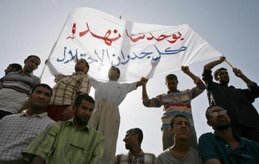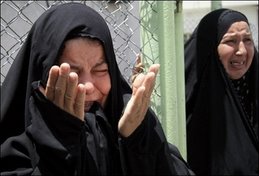Targeting Iraqis As "Big Game"
By Nick Turse
06 November, 2007Tom Dispatch.com
Earlier this month, news of the military's use of Human Terrain Teams -- U.S. combat units operating in Afghanistan and Iraq that contain anthropologists and other social scientists who have traded in their academic robes for body armor -- hit the front-page of the New York Times. While the incorporation of academic experts into combat units has raised ire in some scholarly circles, their use as "cultural advisers" to aid the war effort has been greeted by the military as "a crucial new weapon in counterinsurgency operations" and in the media as an example of increased cultural sensitivity as well as evidence of a new Pentagon willingness to think outside the box.
But the university is only one of a number of areas where an overstretched military, involved in two losing wars, is in a desperate search for new ideas. And humanizing allies and enemies alike has only been one part of the process. Dehumanizing them has been the other. At a recent conference on urban warfare in Washington, D.C., James Lasswell, a retired Marine Corps colonel who now heads the Office of Science and Technology at the Marine Corps Warfighting Laboratory, opened an interesting window into this side of things. He noted that, as part of an instruction course named "Combat Hunter," the Marines have brought in "big-game hunters" to school their snipers in the better use of "optics." According to a September 2007 article by Grace Jean in NationalDefense Magazine, "[T]he lab conducted a war game with Marines, African game hunters and inner city police officers to search for ways to improve training." The program included a 15-minute CD titled "Every Marine a Hunter."
Earlier this year, according to an article by Kimberly Johnson of the Marine Corps Times, Col. Clarke Lethin, chief of staff of the I Marine Expeditionary Force (I MEF) -- a unit based in Camp Pendleton, California that took part in the 2003 invasion of Iraq and will be returning there soon -- indicated that its commanders "believe that if we create a mentality in our Marines that they are hunters and they take on some of those skills, then we'll be able to increase our combat effectiveness." The article included this curious add-on: "The Corps hopes to tap into skills certain Marines may already have learned growing up in rural hunting areas and in urban areas, such as inner cities, said Col. Clarke Lethin, I MEF's chief of staff." Outraged by the statement, one Sgt. Ramsey K. Gregory wrote a letter to the publication asking, "Just what was meant by that comment about the inner city? I hope to God that he's not saying that people from the inner cities are experts in killing each other and that we all just walk around carrying guns."
While the colonel's language -- defended by some -- did seem to suggest that inner-city dwellers lived in an urban jungle of gun-toting hunters of other humans, none of the letters, pro or con, considered quite a different part of the Colonel's equation: the implicit comparison of enemies in urban warfare, today largely Iraqis and Afghans, to animals that are hunted and killed as quarry. As Lethin had unabashedly noted, "We identified a need to ensure our Marines were being the hunters… Hunting is more than just the shooting. It's finding your game."
That military men might indulge in this sort of description was perhaps less than surprising, given the degree to which "hunting" the enemy has been on the lips of America's commander-in-chief. George W. Bush has, on many occasions, invoked the image: "We're hunting them down, one at a time" he likes to say of, for instance, al-Qaeda terrorists, or "we're smoking them out," as he said in November 2001.
In fact, the President needed no big-game hunters to coach him on his optics or anything else. He's talked incessantly of hunting humans -- in speeches to American troops, at photo ops with foreign leaders, at family fundraisers, even in the midst of remarks about homeownership.
Nor is there anything new about Americans treating racial and ethnic enemies as the equivalent of animals to be abused or killed. In his memoir of the Vietnam War, Dispatches, acclaimed combat correspondent Michael Herr, for example, recalled a young soldier from the Army's 1st Infantry Division who admitted, "Well, you know what we do to animals…. kill ‘em and hurt ‘em and beat on ‘em…. Shit, we don't treat the Dinks [Vietnamese] no different than that." Another veteran, quoted elsewhere remembered, "As soon as I hit boot camp…. they tried to change your total personality…. Right away they told us not to call them Vietnamese. Call them gooks, dinks…. They were like animals, or something other than human…. They told us they're not to be treated with any type of mercy…" Today, the slurs of the Vietnam era have been replaced by "haji" and "raghead," while the big-game hunters and the language that goes with killing animals have added to the atmosphere of dehumanization.
That program of instruction is, however, just one recent example of an undercurrent within the military's institutional culture that implicitly reduces people to animals. It's not just in the language of everyday anger and dismissal by soldiers in a strange land where danger is everywhere and it's difficult to tell friend from foe. It's lodged right in the institutional language, if you care to notice. Last month, a piece in the Washington Post, for example, drew much media attention when it came to light that U.S. Army snipers from the "painted demons" platoon of the 1st Battalion, 501st Infantry Regiment, 25th Infantry Division allegedly took part in "a classified program of 'baiting' their targets" to lure insurgents within their sniper scopes.
"Basically, we would put an item [like a spool of wire or ammunition] out there and watch it," said Capt. Matthew P. Didier, the leader of the elite sniper platoon in a sworn statement. "If someone found the item, picked it up and attempted to leave with the item, we would engage the individual as I saw this as a sign they would use the item against U.S. Forces." While there has been much subsequent discussion about the ethics and legality of such a program, nobody seemed to take note of the hunting language involved. After all, when you "bait" a trap (or a hook), it's to lure an animal (or fish) in for the kill. But "bait" for a human?
While the use of anthropologists and other social scientists has made headlines, the utilization of "big-game hunters" as troop trainers for the "urban jungles" of Iraq has been essentially ignored. Programs stressing cultural sensitivity may be covered, but treating Iraqis scavenging in a weapon-strewn war zone as the equivalent of elephants, water buffalo, or other prized trophies of great white hunters has gone largely unexamined in any meaningful way.
From the commander-in-chief to low-ranking snipers, a language of dehumanization that includes the idea of hunting humans as if they were animals has crept into our world -- unnoticed and unnoted in the mainstream media. Perhaps a few linguistics professors or other social scientists might like to step into the breach and offer their views on the subject -- unless, of course, they've already been mustered into those Human Terrain Teams.
Nick Turse is the associate editor and research director of Tomdispatch.com. He has written for the Los Angeles Times, the San Francisco Chronicle, the Nation, GOOD magazine, the Village Voice, and regularly for Tomdispatch.com. His first book, The Complex, an exploration of the new military-corporate complex in America, is due out in the American Empire Project series by Metropolitan Books in 2008. His new website NickTurse.com (up only in rudimentary form) will fully launch in the coming months.









